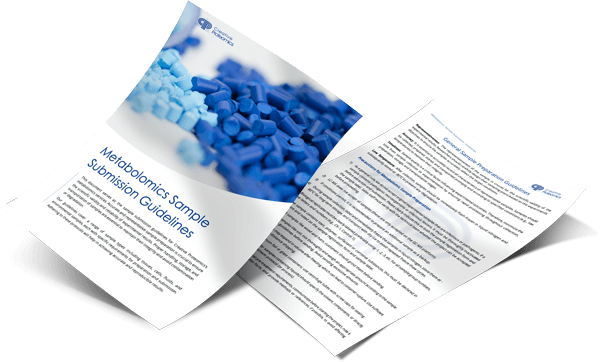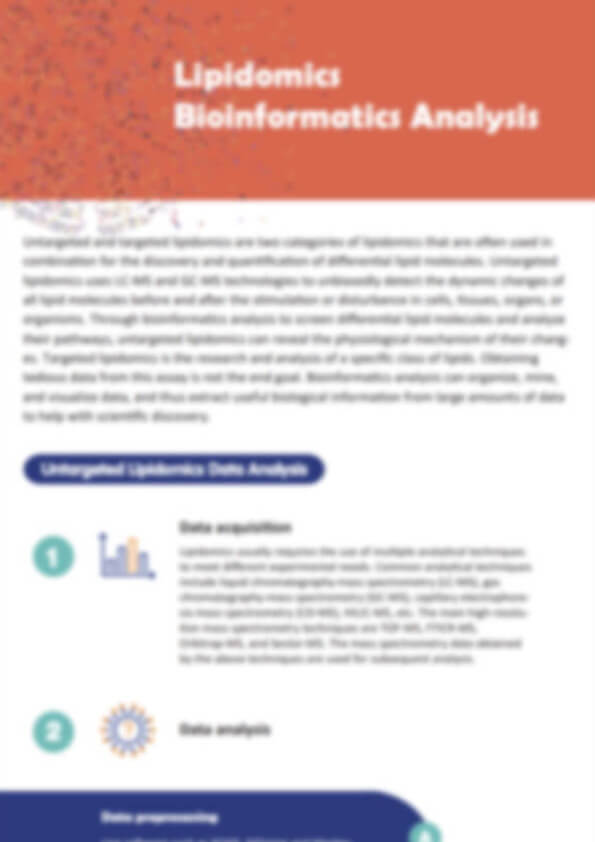Branched Chain Fatty Acids Analysis Service
Creative Proteomics provides specialized branched-chain fatty acids (BCFAs) analysis services using advanced GC-MS and LC-MS/MS platforms. We deliver precise quantification, comprehensive metabolite profiling, and pathway analysis to support research in metabolism, microbiology, nutrition, and bioengineering. Our services solve challenges of low-abundance detection, isomer differentiation, and large-scale sample processing with unmatched sensitivity, reproducibility, and data interpretation.
Submit Your Request Now
×- What We Provide
- Advantage
- Workflow
- Technology Platforms
- Sample Requirements
- FAQ
- Publication
What are Branched Chain Fatty Acids?
Branched-chain fatty acids (BCFAs) are fatty acids characterized by methyl or ethyl branches on their carbon backbone, typically located near the terminal end of the chain. These structural features confer unique physicochemical properties, such as low freezing points and enhanced thermal stability, making them critical for microbial membrane fluidity (e.g., in Bacillus species) and human health. BCFAs are naturally present in dairy products, ruminant meats, fermented foods, and human gut microbiota, where they influence metabolic regulation, immune modulation, and even exhibit anticancer properties.
Branched Chain Fatty Acids Analysis Service Offered by Creative Proteomics
- Targeted Quantitative Analysis of Branched Chain Fatty Acids: Accurate absolute quantification of major and minor BCFAs using isotope-labeled internal standards.
- Untargeted Metabolomics Profiling for Branched Chain Fatty Acids Discovery: Comprehensive identification of known and novel BCFAs and associated metabolites.
- Structural Isomer Differentiation of Branched Chain Fatty Acids: High-resolution separation and identification of iso-, anteiso-, and other methyl-branched isomers.
- Dynamic Analysis of Branched Chain Fatty Acid Biosynthesis Using Stable Isotope Tracers: Measurement of metabolic fluxes and biosynthetic pathways involving BCFAs.
- Comparative BCFA Profiling Across Different Experimental Conditions: Relative quantitation and statistical analysis for differential BCFA expression studies.
- Metabolic Pathway Mapping and Enrichment Analysis Related to Branched Chain Fatty Acids: Integration of BCFA data into biological pathway networks for functional interpretation.
List of Detected Branched Chain Fatty Acids and Related Metabolites
| Category | Detected Compounds (Examples) | Associated Pathways |
|---|---|---|
| Branched Chain Short-Chain Fatty Acids | Isobutyric acid, 2-Methylbutyric acid, Isovaleric acid, 3-Methylvaleric acid, Pivalic acid | Valine, leucine, isoleucine degradation; SCFA metabolism |
| Branched Chain Medium-Chain Fatty Acids | 4-Methyloctanoic acid, 5-Methylnonanoic acid, 6-Methyldecanoic acid, 7-Methylundecanoic acid | Odd-chain FA biosynthesis; mitochondrial β-oxidation |
| Branched Chain Long-Chain Fatty Acids | 13-Methyltetradecanoic acid, 14-Methylpentadecanoic acid, 15-Methylhexadecanoic acid, Phytanic acid, Pristanic acid | Peroxisomal α-/β-oxidation; ether lipid metabolism |
| Branched Chain Fatty Acid Precursors | Valine, Leucine, Isoleucine, α-Ketoisovalerate, α-Keto-β-methylvalerate, α-Ketoisocaproate | BCAA catabolism; propionyl-CoA & isobutyryl-CoA formation |
| CoA-Activated Intermediates | Isobutyryl-CoA, Isovaleryl-CoA, 2-Methylbutyryl-CoA, Propionyl-CoA, Methylmalonyl-CoA | Mitochondrial FA activation; odd-chain FA synthesis |
| Downstream Lipid Derivatives | Branched-chain acylcarnitines (e.g., Isobutyrylcarnitine, Isovalerylcarnitine), Branched-chain phospholipids | Carnitine shuttle; lipid remodeling pathways |
| Related Metabolites in Central Metabolism | Succinyl-CoA, Acetyl-CoA, Pyruvate, 3-Hydroxyisobutyrate, Methylcitrate | TCA cycle integration; anaplerosis |
Advantages of Branched Chain Fatty Acids Assay
- Exceptional Sensitivity and Detection Limits: Our service detects BCFAs as low as 0.5 ng/mL, ensuring even trace amounts are accurately quantified in complex samples.
- Comprehensive Coverage of BCFAs and Metabolites: We offer analysis of over 120 different BCFAs and related metabolites, covering both common and rare iso- and anteiso-isomers for a complete metabolic profile.
- Outstanding Reproducibility and Consistency: Achieving<5% coefficient of variation (CV) for intra-batch replicates, ensuring reliable and reproducible results every time.
- Highly Accurate Quantification: Using stable isotope-labeled internal standards, we ensure >95% accuracy in the quantification of BCFAs, even at low concentrations.
- Tailored to Specific Research Needs: We provide flexible analysis options, from targeted to untargeted approaches, to meet the unique demands of your research project.
- High-Throughput Capabilities: With the ability to process up to 500 samples per batch, our service supports large-scale studies with the same high level of quality.
- Advanced Data Analysis and Interpretation: Comprehensive bioinformatics support, including metabolic pathway analysis, provides actionable insights for deeper understanding of BCFA-related processes.
Workflow for Branched Chain Fatty Acids Analysis Service
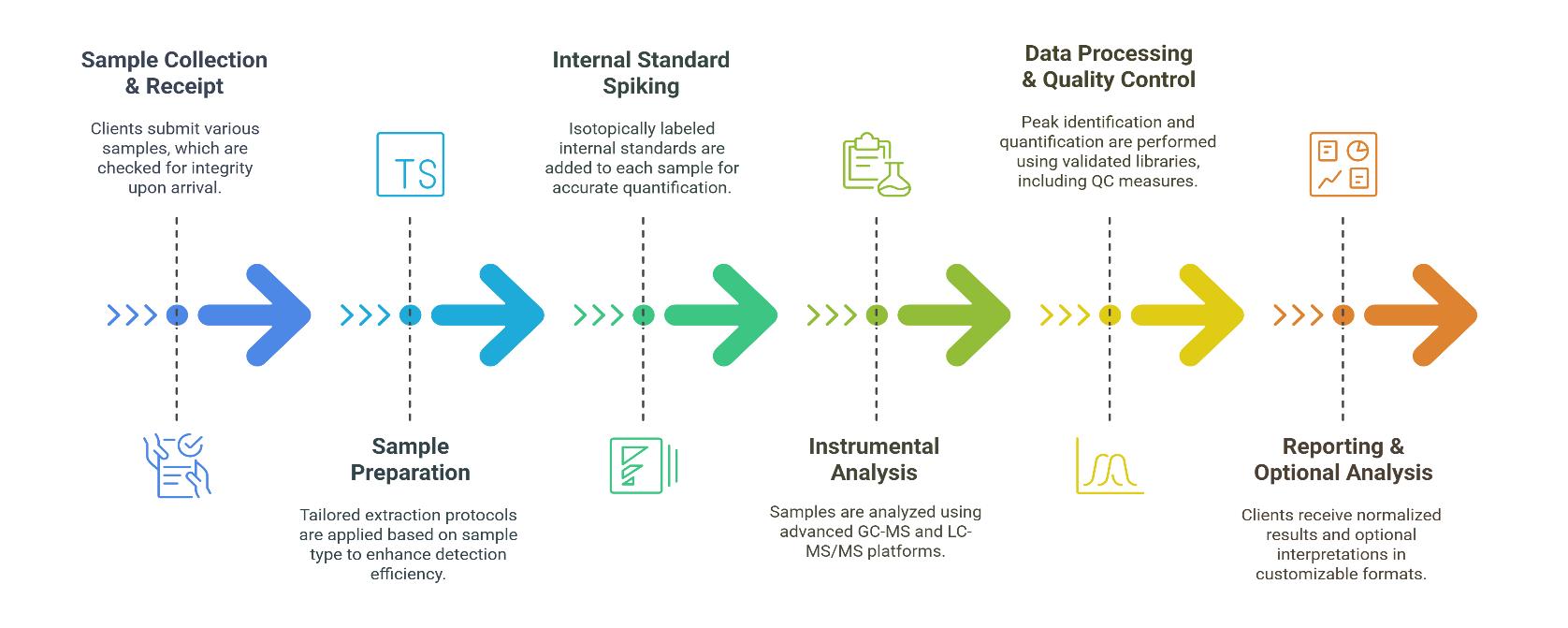
Technology Platform for Branched Chain Fatty Acids Analysis Service
Gas Chromatography-Mass Spectrometry (GC-MS)
System: Agilent 7890B GC + 5977A MSD
Application: Volatile short-chain fatty acids (C2–C6) profiling, including branched isomers.
Key Performance:
- Electron Ionization (EI) mode for robust identification
- Limit of Detection (LOD): 5–10 ng/mL
- Fatty acid methyl ester (FAME) derivatization for enhanced separation
Liquid Chromatography-Mass Spectrometry (LC-MS/MS)
System 1: Thermo Scientific Q Exactive™ Plus Orbitrap + UltiMate 3000 UHPLC
Application: Untargeted profiling of medium- to long-chain BCFAs and polar metabolites
Key Performance:
- Resolving Power: up to 140,000 FWHM
- Mass Accuracy:<3 ppm
System 2: AB Sciex Triple Quad™ 6500+
Application: Targeted, high-sensitivity quantification
Key Performance:
- LLOQ: 1–2 ng/mL for selected analytes
- Scheduled MRM for high-throughput workflows
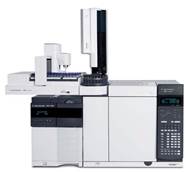
Agilent 7890B-5977A (Figure from Agilent)

SCIEX Triple Quad™ 6500+ (Figure from Sciex)
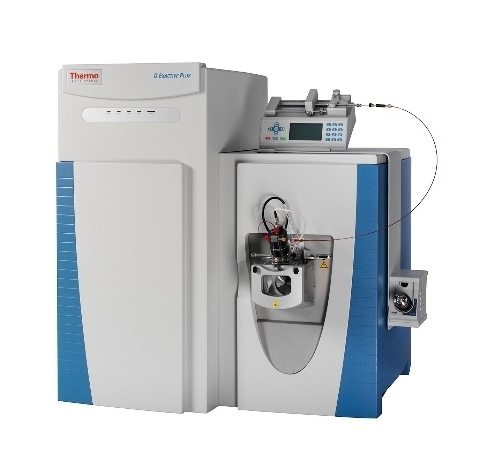
Thermo Fisher Q Exactive (Figure from Thermo Fisher)
Sample Requirements for Branched Chain Fatty Acids Analysis Service
| Sample Type | Minimum Amount Required | Storage Conditions | Sample Preparation |
|---|---|---|---|
| Serum/Plasma | ≥ 100 µL | -80°C (Avoid repeated freeze-thaw cycles) | Centrifuge to separate plasma/serum |
| Tissue | ≥ 100 mg | Snap-frozen, stored at -80°C | Homogenize in appropriate buffer |
| Cell Pellet | ≥ 5 x 10⁶ cells | Snap-frozen, stored at -80°C | Wash and centrifuge cell pellets |
| Microbial Cultures | ≥ 10 mL | Centrifuge and pellet stored at -80°C | Harvest and freeze microbial pellet |
| Food Samples | ≥ 500 mg | Freeze-dried preferred, stored at -20°C | Grind or homogenize sample |
| Plant Materials | ≥ 100 mg | Snap-frozen or freeze-dried, stored at -80°C | Freeze or dry, then grind sample |
Applications of Branched Chain Fatty Acids Assay Service
Metabolic Profiling in Microbial Communities
Understanding microbial metabolic pathways and their role in ecosystem functioning.
Food Quality Control and Flavor Development
Evaluating the impact of BCFAs on food flavor profiles, texture, and aroma.
Agricultural Biotechnology
Assessing the metabolic impact of BCFAs in genetically modified crops and plants.
Animal Nutrition Research
Investigating the role of BCFAs in livestock feed formulations and animal growth.
Biotechnological Production of Specialty Fatty Acids
Optimization of microbial and industrial processes for high-value BCFA production.
Environmental and Soil Microbiome Studies
Exploring the influence of BCFAs on soil microbial health and nutrient cycling.
Demo

(A) GC-MS chromatogram of SCFA mixture separation. (B) SCFA concentrations (μg/mL). (C) Mass spectra and molecular ions (m/z) of Ac, PA, Iso-BA, BA, and Iso-VA (Kao, Ming‐Shan, et al., 2017).
FAQ of Branched Chain Fatty Acids Analysis Service
Can you analyze branched chain fatty acids in complex biological matrices like tissues or microbial cultures?
Yes, we can efficiently analyze BCFAs in complex biological samples such as tissues, cell cultures, and microbial systems. Our methods are optimized for both simple and challenging matrices to ensure accurate results.
How do I send my samples to Creative Proteomics for analysis?
You can send your samples via standard shipping or express courier to our lab. We recommend using dry ice or liquid nitrogen for preservation during transit, especially for tissue or biological samples. Contact us for specific shipping instructions.
Are there any specific storage requirements for my samples before submission?
Yes, most samples should be frozen at -80°C to preserve the integrity of the BCFAs. If you're unsure about storage or handling, feel free to contact us for guidance on specific sample types.
Can you provide results for a combination of fatty acids and other metabolites in the same analysis?
Yes, we can integrate fatty acid analysis with other metabolites, including amino acids, lipids, and other key intermediates, into a comprehensive metabolic profile.
Can I perform a comparative analysis between different sample groups?
Yes, we offer comparative analysis between different sample groups to identify variations in BCFA profiles under different experimental conditions. This can be useful in applications such as dietary studies, environmental exposures, or experimental treatments.
What is the range of fatty acids that can be detected through your service?
We can analyze a wide range of branched-chain fatty acids, including short-chain (C2-C6), medium-chain (C7-C12), and long-chain (C13-C24) fatty acids. The exact range depends on the sample matrix and the methodology chosen for the analysis.
Are there any sample types that cannot be processed for BCFA analysis?
While most biological and industrial samples can be processed, we may have limitations with certain types of solid or highly viscous materials that require specialized sample preparation. If you have concerns, please contact us to discuss your specific sample type.
What level of detail is included in the data reports?
Our reports include detailed quantification, metabolic pathway mapping, and statistical analysis. We also provide a clear interpretation of the data, including any relevant trends, correlations, or notable findings related to BCFA metabolism.
Can your service be used for large-scale studies with hundreds or thousands of samples?
Yes, we have the capacity to handle high-throughput analyses, processing hundreds or thousands of samples for large-scale studies. Our workflows are designed for efficiency and scalability to meet the needs of large research projects.
How can I interpret the metabolic pathway analysis provided with my results?
We offer comprehensive pathway analysis that includes visual maps and statistical insights. Our bioinformatics team can assist with interpreting specific findings, helping you connect your BCFA data to biological functions and metabolic networks.
Can you analyze branched chain fatty acids in plant-based samples?
Yes, we specialize in analyzing BCFAs in plant samples, including leaves, seeds, and roots. We can detect how BCFAs relate to metabolic changes during plant growth or response to environmental factors.
Are there any limitations on the number of BCFAs detected in each analysis?
We offer a highly customizable service that can detect over 120+ different BCFAs and related metabolites. The number of detected compounds will depend on your project specifications and the sample matrix.
How is the analysis of branched chain fatty acids useful in metabolic engineering?
In metabolic engineering, BCFA analysis allows researchers to monitor the efficiency of biosynthetic pathways, assess product yield, and optimize microbial or plant systems engineered for the production of biofuels, pharmaceuticals, or specialty chemicals.
Can the service be used for environmental or soil microbiome studies?
Yes, our service is highly applicable to environmental and soil microbiome studies, where BCFA profiles can provide insights into microbial diversity, ecological interactions, and the effects of various environmental conditions on microbial communities.
Learn about other Q&A.
Branched Chain Fatty Acids Analysis Service Case Study
Publications
Here are some publications in Lipidomics research from our clients:

- Resting natural killer cell homeostasis relies on tryptophan/NAD+ metabolism and HIF‐1α. 2023. https://doi.org/10.15252/embr.202256156
- DNA stimulates SIRT6 to mono-ADP-ribosylate proteins within histidine repeats. 2024. https://doi.org/10.1101/2024.07.31.606047
- A comprehensive biochemical characterization of settlement stage leptocephalus larvae of bonefish (Albula vulpes). 2021. https://doi.org/10.1111/jfb.14846
- High Levels of Oxidative Stress Early after HSCT Are Associated with Later Adverse Outcomes. 2024. https://doi.org/10.1016/j.jtct.2023.12.096
- Novakomyces olei sp. nov., the First Member of a Novel Taphrinomycotina Lineage. 2021. https://doi.org/10.3390/microorganisms9020301
Reference
- Kao, Ming‐Shan, et al. "Microbiome precision editing: Using PEG as a selective fermentation initiator against methicillin‐resistant Staphylococcus aureus." Biotechnology journal 12.4 (2017). https://doi.org/10.1002/biot.201600399


